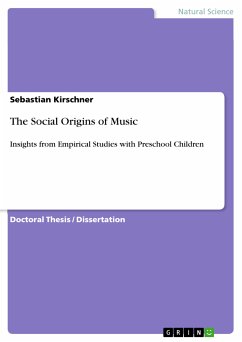
The Social Origins of Music (eBook, ePUB)
Insights from Empirical Studies with Preschool Children
Sofort per Download lieferbar
Statt: 39,99 €**
29,99 €
inkl. MwSt. und vom Verlag festgesetzt.
**Preis der gedruckten Ausgabe (Broschiertes Buch)
Alle Infos zum eBook verschenkenWeitere Ausgaben:

PAYBACK Punkte
0 °P sammeln!
Doctoral Thesis / Dissertation from the year 2011 in the subject Biology - Evolution, grade: magna cum laude, Humboldt-University of Berlin (Institut für Theoretische Biologie), language: English, abstract: Creating music is a distinctive behavior of our species: Humans of all cultures occasionally gather to make music together. However, there is discussion amongst scientists as to whether such behavior is a manifestation of innate psychological mechanisms that evolved as adaptations for music, or whether the diversity of musical behavior simply exemplifies the inventiveness of the human mind...
Doctoral Thesis / Dissertation from the year 2011 in the subject Biology - Evolution, grade: magna cum laude, Humboldt-University of Berlin (Institut für Theoretische Biologie), language: English, abstract: Creating music is a distinctive behavior of our species: Humans of all cultures occasionally gather to make music together. However, there is discussion amongst scientists as to whether such behavior is a manifestation of innate psychological mechanisms that evolved as adaptations for music, or whether the diversity of musical behavior simply exemplifies the inventiveness of the human mind, in which case music should be considered a product of human culture. Scholars advocating the latter view divide further into those who believe that music is an evolutionary by-product, existing only for hedonistic reasons, and those who argue that certain musical behaviors emerged because they serve some culturally adaptive function. The goal of my dissertation was to add new empirical data to this debate by conducting behavioral studies with preschool children. In study 1 I tested the hypothesis that certain musical rituals emerged to foster social bonding, ultimately increasing prosocial in-group behavior. I found that joint music making enhances subsequent cooperative and helpful behavior among pairs of 4-year-old children. In study 2 I investigated the ontogeny of rhythmic entrainment, our ability to move in synchrony to a musical beat. I found that children spontaneously entrain their movements to an external drum beat at earlier ages and with higher accuracy if that beat is presented in a social context. Study 2 revealed large inter-individual differences in synchronization accuracy. To explain these, I hypothesized that rhythmic entrainment develops via social learning processes during early musical enculturation. I extended the original design of study 2 by adding a new condition (joint drumming without visual access to the partner's movements) and a questionnaire about the participants' musical experience. I collected comparable data from Germany and Brazil, assuming that children from those two countries gain qualitatively different experience with music. I found that in both samples the differences in synchronization accuracy correlated with those in musical experience. Furthermore, only German children tended to drum out of synchrony if the partner's movements were hidden from view. I discuss my results in light of the above scenarios and come to the conclusion that music's apparent adaptiveness to various instances of its use can be best explained by cumulative cultural evolution.
Dieser Download kann aus rechtlichen Gründen nur mit Rechnungsadresse in A, B, BG, CY, CZ, D, DK, EW, E, FIN, F, GR, HR, H, IRL, I, LT, L, LR, M, NL, PL, P, R, S, SLO, SK ausgeliefert werden.













